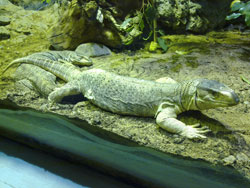Varanus Yemenensis
Bohme, Joger & Schatti 1989Yemen monitor.
 |
The Yemen monitor is similar in appearance to V.albigularis, especially to the eastern form V.albigularis microstictus. It differs from the African lizards in its lack of pattern (except for a yellow band over the snout) and its smaller scales. Examination of blood proteins, hemipenal and lung morphology provide evidence that the Yemen monitor is a valid species (Bohme et al 1989, Bohme 1991b, Becker 1991).
The Yemen monitor reaches a total length of at leasl 110cm (50cm SVL). This is a stoutly built species with a tail 108-120% of the SVL. They are known from the Yemen Arab Republic, the Peoples Democratic Republic of Yemen and Saudi Arabia (all location data in Bohme et al (1989)' where they live in scrubland and dry forest in the foothills of mountains up to at least 1300m above sea level. The Yemen monitor is most commonly seen close to shallow water or in dry river beds. Its diet is said to consist largely of insects (especially beetles), snails and other invertebrates. They probably take larger prey when the opportunity arises. Activity may be reduced or suspended during the driest pan of the year (January to March). Despite the excitement over the discovery of this lizard there has been no rush of ecologists to Arabia to study it in its natural environment.
In captivity the Yemen monitor appears rather to be a rather docile animal. Large males tend to dominate smaller ones and may prevent them from feeding properly. Behaviour similar to mating has been observed between males but so far there are no records of bipedal combat in this species. When given the opporlunity they will dig deep burrows under a rock or tree stump (Honneger, pers. comm., Saegesser, pers. comm.). In addition to invertebrates, the Yemen monitor will feed on mice, fish and birds in captivity (Bohme et al 1989) So far there are no records of captive breeding.
Attribution / Courtesy: Daniel Bennett. 1995. A Little Book of Monitor Lizards. Viper Press U.K.





